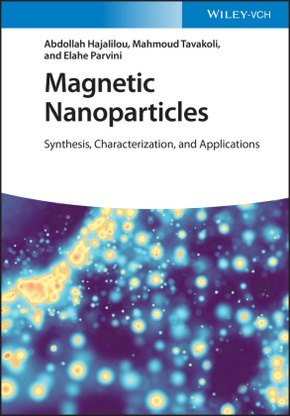Magnetic Nanoparticles - Synthesis, Characterization and Applications
| Verlag | Wiley-VCH |
| Auflage | 2022 |
| Seiten | 352 |
| Format | 17,5 x 2,0 x 25,0 cm |
| Gewicht | 816 g |
| Artikeltyp | Englisches Buch |
| ISBN-10 | 3527350977 |
| EAN | 9783527350971 |
| Bestell-Nr | 52735097A |
The book highlights the applications of magnetic nanoparticles in fields such as battery research, environmental protection and medicine, complemented by a review of advanced synthesis and characterization methods.
Inhaltsverzeichnis:
1 Introduction to Magnetic Materials
1.1 Theory and Fundamentals of Magnetization
1.2 Types of Magnetism
1.3 Extrinsic and Intrinsic Characteristics of Magnetic Materials
2 Types and Characteristics of Magnetic Materials
2.1 Introduction
2.2 Soft and Hard Magnetic Materials
2.3 Hysteresis Loop
2.4 Magnetic Characteristic Measurements
2.5 Magnetic Losses
3 Insights into the Synthesis of Nanostructured Magnetic Materials
3.1 Introduction
3.2 The Synthesis Process of Magnetic Nanoparticles
3.3 The Importance of the Synthesis and/or Preparation Methods
3.4 Dependency of Particle Size and Shape on the Synthesis Route
3.5 Questions Related to the Selected Synthesis Route
3.6 Dependency of Magnetic Behaviors on Particle/Grain Size
3.7 Dependency of Magnetic Behaviors on Particle/Grain Shape
3.8 Introduction to Wet-Chemical Synthesis Route
3.9 Introduction to Solid-state Routes to Synthesize Magnetic Nanoparticles
3. 10 Some Methods for Extraction of Iron Oxide Nanoparticles from Industrial Wastes
4 Surface Modification of Magnetic Nanoparticles
4.1 Introduction
4.2 Employed Technical Resources for Surface Modification
4.3 Surface Modification of Magnetic Nanoparticles with Surfactant
4.4 Current Trends for Surface Modification of Nanomaterials
4.5 Summary
5 Insight into a Superconducting Quantum Interference Device (SQUID)
5.1 Introduction to SQUID
5.2 Superconducting Materials Used in SQUID
5.3 What is the Basic Principle in SQUID VSM Magnetometer?
5.4 Superconductivity
5.5 Josephson Tunneling (JT) Phenomenon
5.6 Utilizations and Applications of SQUID
5.7 Advantages and Disadvantages of SQUID Compared to other Techniques in Characterization of Magnetic Nanomaterials
6 The principle of SQUID Magnetometry and its Contribution in MNPs Evaluation
6.1 Introduction
6.2 The Correct Procedure to Perform the Zero Field Cooling (ZFC ) and Field Cooling (FC) Magnetic Study
6.3 The Concept of Merging Zero Field Cooled (ZFC) and Field Cooled (FC) Curve Completely with Each Other
6.4 Types of Information Obtained from the ZFC and FC Curves
6.5 SQUID Magnetometry: Magnetic Measurements
7 Type of Interactions in Magnetic Nanoparticles
7.1 Introduction
7.2 Magnetic Dipole-Dipole Interaction between Magnetic Nanoparticles
7.3 Exchange Interaction
7.4 Dipolar Interactions
7.5 Spin-orbit Interaction
8 Insight into Susceptibility Measurements in Nanostructured Magnetic Materials
8.1 Introduction
8.2 Information Obtained from Susceptibility Measurements
8.3 Insight into interaction between magnetic nanoparticles and used models
8.4 AC Susceptibility Measurement Evaluation
9 Induced Effects in Nanostructured Magnetic Materials
9.1 Introduction
9.2 The Spin-Canted Effect
9.3 Spin-glass-like Behavior in Magnetic Nanoparticles
9.4 Reentrant Spin Glass (RSG) Behavior in Magnetic Nanoparticles
9.5 Finite Size Effects on Magnetic Properties
9.6 Surface Effect in Nanosized Particles
9.7 Memory Effect
10 Insight into Superparamagnetism in Magnetic Nanoparticles
10.1 Introduction
10.2 Superparamagnetism
10.3 SPM Description Based on Magnetization Hysteresis Loop (M-H or B-H)
10.4 SPM detection based on ZFC and FC magnetization curves
11 Mössbauer Spectroscopy
11.1 Introduction to Mössbauer Spectroscopy
11.2 Observed Effects in Mössbauer
11.3 Hyperfine Interactions
11.4 Mössbauer Spectroscopy Applied to Magnetism
12 Applications of Magnetic Nanoparticles
12.1 Introduction
12.2 Magnetic Nanoparticles Application in Engineering Fields
12.3 Magnetic Nanoparticles Application in Energy
12.4 Magnetic Nanoparticles Application in Medical Sciences
12.5 Other General Applications of Magnetic Nanoparticles

